
Chief Minister Himanta Biswa Sarma has announced Assam’s first wildlife health-research institute in Assam, to be established in Dibrugarh. This initiative aims to advance animal healthcare, promote scientific conservation, and protect endangered wildlife.
He made the announcement during an event focused on biodiversity protection. Sarma emphasized that Assam needs better infrastructure to care for its unique and vulnerable wildlife.
Read More: Assam Red Alert: Kalo River at Danger Level
Dibrugarh Chosen for Strategic Location
The wildlife health-research institute in Assam will be built in Dibrugarh. The location offers proximity to wildlife-rich regions such as Dibru-Saikhowa National Park and Dehing Patkai.
Officials say Dibrugarh was chosen because it is centrally located in Upper Assam, making access easier for wildlife teams. The area has also faced rising instances of animal illness and injuries due to habitat stress and climate shifts.
Focus on Endangered Species and Field Diagnostics
This new facility will focus on diagnosing animal diseases quickly and treating injured wildlife. Species such as the one-horned rhino, elephants, and swamp deer will benefit from rapid-response medical support.
The wildlife health-research institute in Assam will include labs for virology, parasitology, and pathology. These will help detect diseases that often go unnoticed in the wild.
Sarma stated that the goal is to treat, monitor, and even prevent disease outbreaks before they spread. He added that this step will also help reduce human-animal conflict and wildlife deaths.
Experts and Officials Praise the Initiative
Veterinary experts and conservation groups welcomed the announcement. Dr. N. Goswami, a wildlife vet from Kaziranga, said that timely diagnosis could save many animals, especially during floods or heatwaves.
He added that the wildlife health-research institute in Assam will bridge a critical gap in the state’s conservation infrastructure.
Forest officers are also being trained to handle basic field diagnostics. This hands-on support will allow rangers to offer first aid to wild animals before transferring them to the institute.
Boost for Research and Veterinary Education
The institute will also function as a research and training hub. It will support veterinary students, wildlife biologists, and researchers working on conservation health.
The wildlife health-research institute in Assam will have tie-ups with veterinary colleges and national bodies like the Wildlife Institute of India. Internships, field training, and academic exchanges will be part of the program.
Officials confirmed that construction will begin by the end of this year. The facility is expected to become operational in 2026.
Conservation Linked to Climate and Human Safety
Assam’s biodiversity is under increasing pressure. Forest loss, encroachment, floods, and changing weather patterns are affecting animal movement and health.
Sarma explained that the wildlife health-research institute in Assam is also about public safety. Diseases that spread from animals to humans—zoonotic diseases—can now be tracked early. Monitoring wildlife health closely reduces that risk.
Assam faces these threats often, especially in monsoon seasons when water-borne diseases and animal displacements are common.
Assam’s Growing Role in Conservation
With this new facility, Assam is not just protecting animals but building scientific capacity. It sets an example for other states to follow.
Sarma concluded, “This wildlife health-research institute in Assam will be a landmark step toward a healthier and safer future for both animals and people.”



